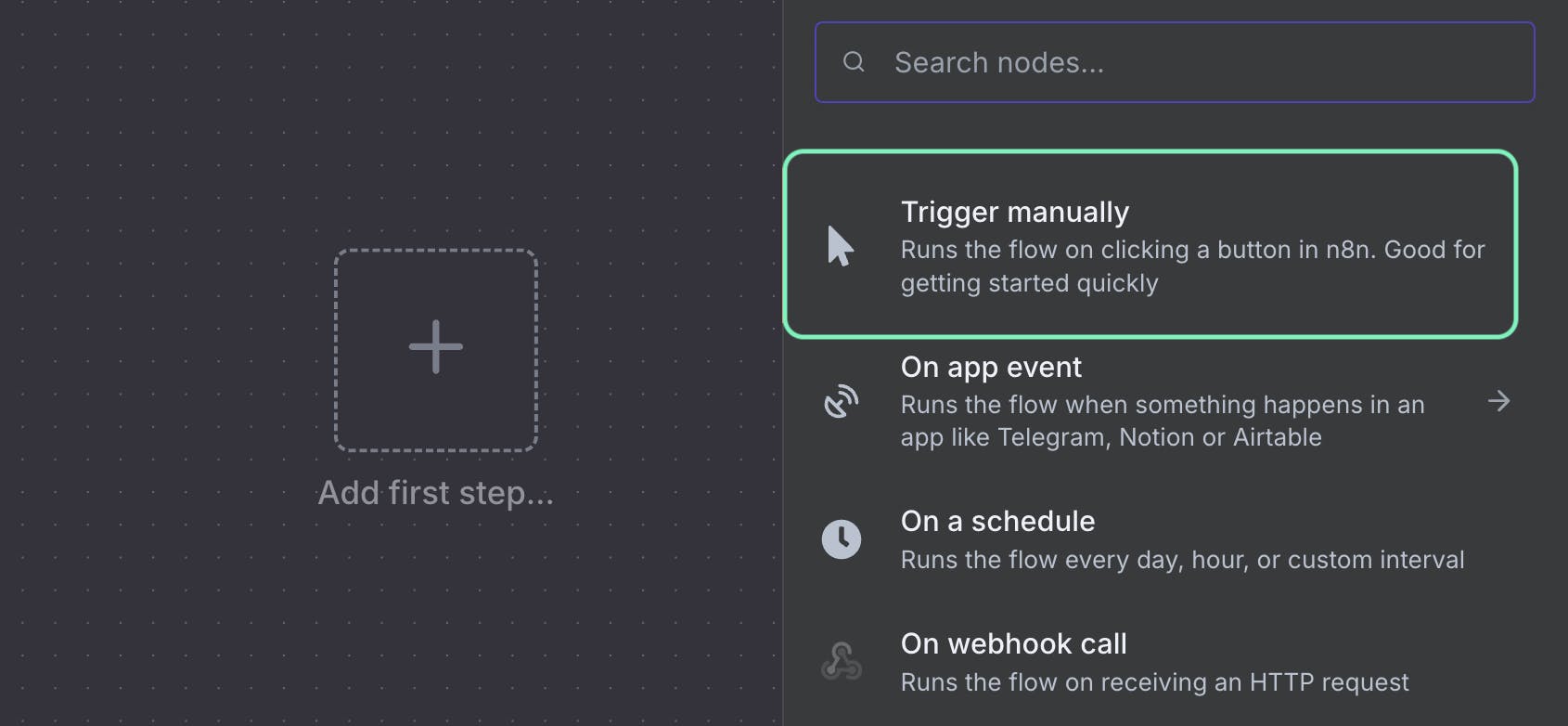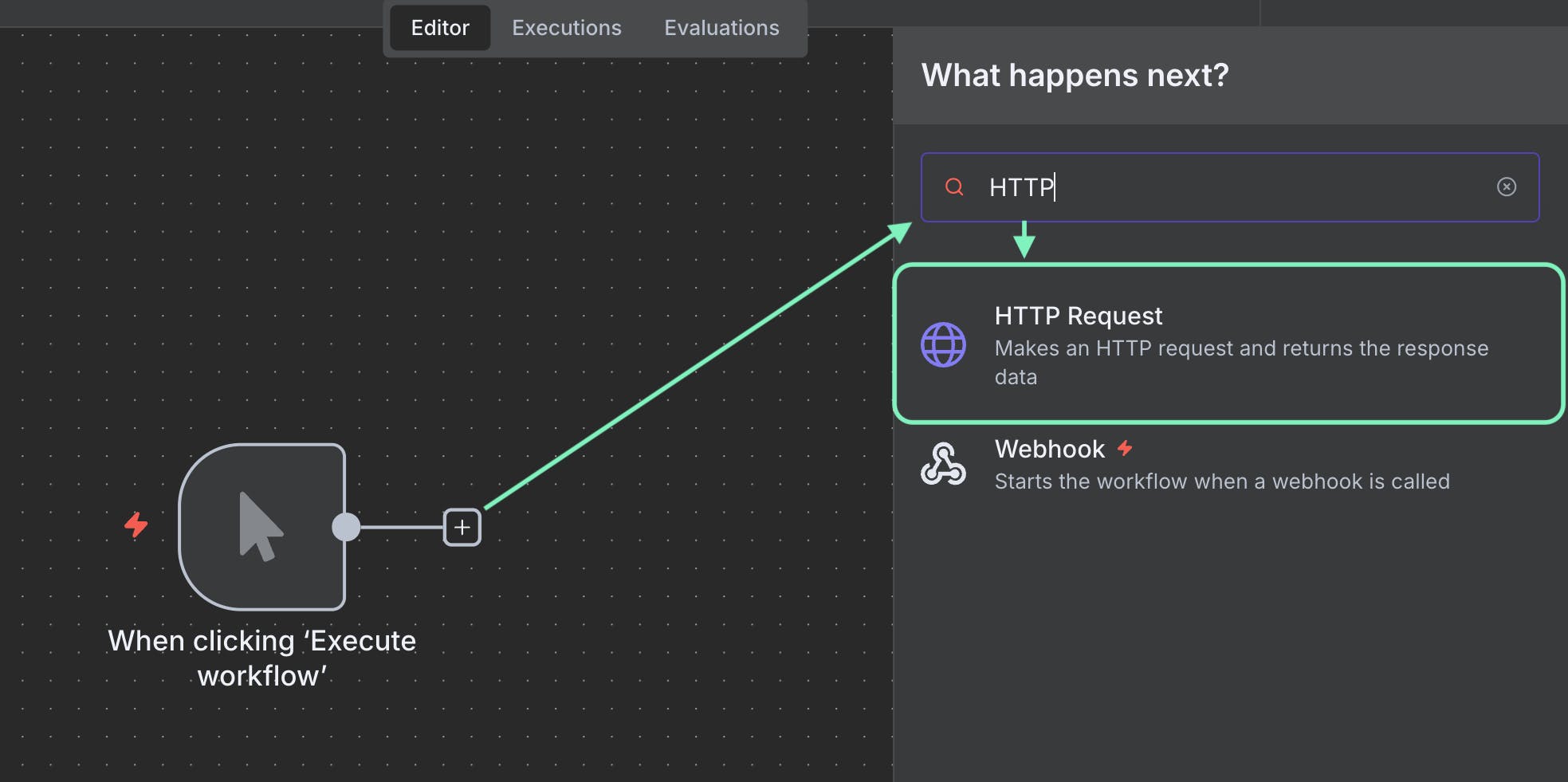n8n's low-code workflow automation combined with Roundproxies' rotating IP infrastructure lets you build enterprise-grade scrapers without drowning in boilerplate code. This guide shows you how to build a smart proxy rotation system that actually survives at scale, complete with health monitoring and automatic failover mechanisms.
What Makes This Setup Different
Most n8n scraping tutorials stop at basic HTTP requests. We're going deeper - building a proxy management system that:
- Rotates IPs intelligently based on success rates
- Monitors proxy health in real-time
- Automatically retries failed requests through different proxies
- Bypasses rate limits without manual intervention
Prerequisites and Initial Setup
Before diving into the workflow, you'll need:
- An n8n instance (self-hosted or cloud)
- A Roundproxies account with residential or ISP proxies
- Basic understanding of HTTP requests and JSON
Setting Up Your Roundproxies Account
Roundproxies offers two proxy types that work perfectly with n8n:
Residential Proxies: Best for scraping heavily protected sites. They rotate automatically with each request and provide IPs from real devices.
ISP Proxies: Faster and more stable, ideal for high-volume scraping of moderately protected sites.

After signing up, grab your proxy credentials from the dashboard. You'll get:
- Proxy endpoint:
proxy.roundproxies.com:8080 - Username: Your account username
- Password: Your proxy password
Step 1: Configure the HTTP Request Node with Proxy Support
Start by creating a new workflow in n8n. Add an HTTP Request node and configure it for proxy usage.

Basic Proxy Configuration
In your HTTP Request node, scroll down to the Options section and add the proxy URL:
http://username:password@proxy.roundproxies.com:8080
But here's where most tutorials end. Let's make this smarter.
Building a Dynamic Proxy Rotator
Instead of hardcoding one proxy, we'll create a system that manages multiple proxy endpoints. Add a Code node before your HTTP Request:
// Store your proxy configurations
const proxyPool = [
{
url: 'http://user1:pass1@proxy.roundproxies.com:8080',
region: 'us',
successRate: 1.0,
lastUsed: null,
failures: 0
},
{
url: 'http://user2:pass2@proxy.roundproxies.com:8081',
region: 'eu',
successRate: 1.0,
lastUsed: null,
failures: 0
},
{
url: 'http://user3:pass3@proxy.roundproxies.com:8082',
region: 'asia',
successRate: 1.0,
lastUsed: null,
failures: 0
}
];
// Load previous proxy stats from workflow static data
const staticData = $getWorkflowStaticData('global');
const proxyStats = staticData.proxyStats || {};
// Update pool with saved stats
proxyPool.forEach(proxy => {
if (proxyStats[proxy.url]) {
proxy.successRate = proxyStats[proxy.url].successRate;
proxy.failures = proxyStats[proxy.url].failures;
proxy.lastUsed = proxyStats[proxy.url].lastUsed;
}
});
Now, let's implement intelligent selection logic:
// Smart proxy selection based on success rate and timing
function selectProxy(pool, targetRegion = null) {
const now = Date.now();
const cooldownPeriod = 5000; // 5 seconds between uses
// Filter available proxies
let available = pool.filter(p => {
// Skip if recently used
if (p.lastUsed && (now - p.lastUsed) < cooldownPeriod) {
return false;
}
// Skip if too many failures
if (p.failures > 5) {
return false;
}
// Filter by region if specified
if (targetRegion && p.region !== targetRegion) {
return false;
}
return true;
});
// If no proxies available, reset and use all
if (available.length === 0) {
available = pool.filter(p => p.failures < 10);
}
// Weighted random selection based on success rate
const totalWeight = available.reduce((sum, p) => sum + p.successRate, 0);
let random = Math.random() * totalWeight;
for (const proxy of available) {
random -= proxy.successRate;
if (random <= 0) {
proxy.lastUsed = now;
return proxy;
}
}
// Fallback to first available
return available[0];
}
// Select the best proxy for this request
const selectedProxy = selectProxy(proxyPool, $json.targetRegion);
return {
proxy: selectedProxy.url,
proxyData: selectedProxy
};
Step 2: Implement Request Execution with Error Handling
Now we need to actually make the request and handle potential failures intelligently. Add another Code node after your HTTP Request:
// Get the response from the HTTP node
const response = $input.all()[0];
const proxyData = $node["Proxy Selector"].json.proxyData;
// Load static data
const staticData = $getWorkflowStaticData('global');
let proxyStats = staticData.proxyStats || {};
// Initialize stats for this proxy if needed
if (!proxyStats[proxyData.url]) {
proxyStats[proxyData.url] = {
totalRequests: 0,
successfulRequests: 0,
successRate: 1.0,
failures: 0,
lastUsed: null
};
}
// Check if request was successful
const isSuccess = response.statusCode >= 200 && response.statusCode < 300;
// Update proxy statistics
proxyStats[proxyData.url].totalRequests++;
if (isSuccess) {
proxyStats[proxyData.url].successfulRequests++;
proxyStats[proxyData.url].failures = 0; // Reset failure counter
} else {
proxyStats[proxyData.url].failures++;
}
// Calculate new success rate
proxyStats[proxyData.url].successRate =
proxyStats[proxyData.url].successfulRequests /
proxyStats[proxyData.url].totalRequests;
proxyStats[proxyData.url].lastUsed = Date.now();
// Save updated stats
$getWorkflowStaticData('global').proxyStats = proxyStats;
// Return the response with metadata
return {
success: isSuccess,
statusCode: response.statusCode,
data: response.body,
proxyUsed: proxyData.url,
proxyRegion: proxyData.region,
successRate: proxyStats[proxyData.url].successRate
};
Step 3: Add Intelligent Retry Logic
Failed requests shouldn't just fail silently. Let's add a retry mechanism that switches proxies on failure. Create a Loop node with the following configuration:
// Retry configuration
const maxRetries = 3;
const currentAttempt = $runIndex || 0;
// Check if we should retry
if (currentAttempt >= maxRetries) {
throw new Error('Max retries reached');
}
// Get the last response
const lastResponse = $node["Response Handler"].json;
// Continue loop if request failed
if (!lastResponse.success) {
// Wait before retrying (exponential backoff)
const waitTime = Math.pow(2, currentAttempt) * 1000;
await new Promise(resolve => setTimeout(resolve, waitTime));
return {
shouldRetry: true,
attempt: currentAttempt + 1,
lastError: lastResponse.statusCode
};
}
// Success - exit loop
return {
shouldRetry: false,
finalResponse: lastResponse
};
Step 4: Parse and Extract Data
Once we have a successful response, we need to extract the actual data. Add an HTML Extract node or a Code node for custom parsing:
// Parse HTML response
const cheerio = require('cheerio');
const html = $json.data;
const $ = cheerio.load(html);
// Example: Extract product data
const products = [];
$('.product-item').each((index, element) => {
const product = {
title: $(element).find('.product-title').text().trim(),
price: $(element).find('.price').text().trim(),
url: $(element).find('a').attr('href'),
image: $(element).find('img').attr('src'),
availability: $(element).find('.availability').text().trim(),
scraped_at: new Date().toISOString(),
proxy_region: $json.proxyRegion
};
products.push(product);
});
// Add metadata about the scraping session
return {
products: products,
metadata: {
total_products: products.length,
proxy_used: $json.proxyUsed,
success_rate: $json.successRate,
timestamp: new Date().toISOString()
}
};
Step 5: Build a Proxy Health Monitoring System
Here's where we go beyond basic scraping. Create a separate workflow that monitors your proxy health:
// Proxy health check workflow
const testUrls = [
'http://httpbin.org/ip',
'http://ipinfo.io/json',
'https://api.ipify.org?format=json'
];
const proxyPool = [
// Your proxy configurations
];
const healthResults = [];
for (const proxy of proxyPool) {
const proxyHealth = {
proxy: proxy.url,
region: proxy.region,
tests: [],
overallHealth: 'unknown'
};
for (const testUrl of testUrls) {
try {
const startTime = Date.now();
// Make test request through proxy
const response = await $http.request({
method: 'GET',
url: testUrl,
proxy: proxy.url,
timeout: 10000
});
const responseTime = Date.now() - startTime;
proxyHealth.tests.push({
url: testUrl,
success: true,
responseTime: responseTime,
statusCode: response.statusCode
});
} catch (error) {
proxyHealth.tests.push({
url: testUrl,
success: false,
error: error.message
});
}
}
// Calculate overall health score
const successRate = proxyHealth.tests.filter(t => t.success).length / proxyHealth.tests.length;
const avgResponseTime = proxyHealth.tests
.filter(t => t.success)
.reduce((sum, t) => sum + t.responseTime, 0) / proxyHealth.tests.filter(t => t.success).length;
proxyHealth.overallHealth = successRate === 1 ? 'healthy' :
successRate > 0.5 ? 'degraded' :
'unhealthy';
proxyHealth.successRate = successRate;
proxyHealth.avgResponseTime = avgResponseTime;
healthResults.push(proxyHealth);
}
// Store health results for use in main workflow
$getWorkflowStaticData('global').proxyHealth = healthResults;
return healthResults;
Step 6: Handle Rate Limiting and Throttling
Smart scrapers don't hammer servers. Add a rate limiter to your workflow:
// Rate limiting implementation
const rateLimits = {
'example.com': { requests: 10, window: 60000 }, // 10 req/min
'api.example.com': { requests: 100, window: 3600000 }, // 100 req/hour
'default': { requests: 30, window: 60000 } // 30 req/min default
};
function getRateLimiter(domain) {
const staticData = $getWorkflowStaticData('global');
const requestLog = staticData.requestLog || {};
if (!requestLog[domain]) {
requestLog[domain] = [];
}
const now = Date.now();
const limit = rateLimits[domain] || rateLimits.default;
// Clean old entries
requestLog[domain] = requestLog[domain].filter(
timestamp => now - timestamp < limit.window
);
// Check if we can make a request
if (requestLog[domain].length >= limit.requests) {
const oldestRequest = requestLog[domain][0];
const waitTime = limit.window - (now - oldestRequest);
return {
canProceed: false,
waitTime: waitTime,
currentRate: requestLog[domain].length
};
}
// Log this request
requestLog[domain].push(now);
$getWorkflowStaticData('global').requestLog = requestLog;
return {
canProceed: true,
currentRate: requestLog[domain].length,
limit: limit.requests
};
}
// Use in your workflow
const targetUrl = new URL($json.url);
const rateLimit = getRateLimiter(targetUrl.hostname);
if (!rateLimit.canProceed) {
// Wait before proceeding
await new Promise(resolve =>
setTimeout(resolve, rateLimit.waitTime)
);
}
Step 7: Implement Session Management for Complex Scraping
Some sites require maintaining sessions across multiple requests. Here's how to handle that with Roundproxies' sticky sessions:
// Session management for multi-step scraping
class ScrapingSession {
constructor(proxy, cookieJar = {}) {
this.proxy = proxy;
this.cookies = cookieJar;
this.sessionId = this.generateSessionId();
}
generateSessionId() {
return 'session_' + Date.now() + '_' + Math.random().toString(36);
}
async request(url, options = {}) {
const requestOptions = {
...options,
proxy: this.proxy,
headers: {
...options.headers,
'Cookie': this.formatCookies(),
'User-Agent': this.getUserAgent()
}
};
const response = await $http.request(requestOptions);
// Update cookies from response
this.updateCookies(response.headers);
return response;
}
formatCookies() {
return Object.entries(this.cookies)
.map(([key, value]) => `${key}=${value}`)
.join('; ');
}
updateCookies(headers) {
const setCookieHeader = headers['set-cookie'];
if (setCookieHeader) {
// Parse and store new cookies
const cookies = Array.isArray(setCookieHeader) ?
setCookieHeader : [setCookieHeader];
cookies.forEach(cookie => {
const [nameValue] = cookie.split(';');
const [name, value] = nameValue.split('=');
this.cookies[name.trim()] = value.trim();
});
}
}
getUserAgent() {
const userAgents = [
'Mozilla/5.0 (Windows NT 10.0; Win64; x64) AppleWebKit/537.36',
'Mozilla/5.0 (Macintosh; Intel Mac OS X 10_15_7) AppleWebKit/537.36',
'Mozilla/5.0 (X11; Linux x86_64) AppleWebKit/537.36'
];
// Use consistent user agent per session
if (!this.userAgent) {
this.userAgent = userAgents[Math.floor(Math.random() * userAgents.length)];
}
return this.userAgent;
}
}
// Usage example: Login and scrape protected content
const session = new ScrapingSession($json.proxy);
// Step 1: Login
const loginResponse = await session.request('https://example.com/login', {
method: 'POST',
body: JSON.stringify({
username: 'user',
password: 'pass'
})
});
// Step 2: Access protected page using same session
const protectedContent = await session.request('https://example.com/dashboard');
return {
sessionId: session.sessionId,
content: protectedContent.body,
cookies: session.cookies
};
Advanced Techniques: Bypassing Anti-Bot Measures
While n8n's HTTP Request node handles basic requests well, sophisticated anti-bot systems require additional strategies:
Browser Fingerprint Randomization
function generateFingerprint() {
const fingerprint = {
'Accept': 'text/html,application/xhtml+xml,application/xml;q=0.9,*/*;q=0.8',
'Accept-Language': randomChoice(['en-US,en;q=0.9', 'en-GB,en;q=0.9', 'de-DE,de;q=0.9']),
'Accept-Encoding': 'gzip, deflate, br',
'DNT': Math.random() > 0.5 ? '1' : '0',
'Connection': 'keep-alive',
'Upgrade-Insecure-Requests': '1'
};
return fingerprint;
}
function randomChoice(array) {
return array[Math.floor(Math.random() * array.length)];
}
// Apply to your request
const headers = {
...generateFingerprint(),
'User-Agent': generateUserAgent()
};
Request Pattern Randomization
// Add random delays between requests
function humanizeRequestTiming() {
const baseDelay = 2000; // 2 seconds
const randomDelay = Math.random() * 3000; // 0-3 seconds random
const totalDelay = baseDelay + randomDelay;
// Sometimes add longer "reading" pauses
if (Math.random() < 0.1) { // 10% chance
return totalDelay + 5000 + Math.random() * 10000; // Extra 5-15 seconds
}
return totalDelay;
}
// Randomize request order
function shuffleUrls(urls) {
const shuffled = [...urls];
for (let i = shuffled.length - 1; i > 0; i--) {
const j = Math.floor(Math.random() * (i + 1));
[shuffled[i], shuffled[j]] = [shuffled[j], shuffled[i]];
}
return shuffled;
}
Monitoring and Alerting
Set up a monitoring dashboard to track your scraping performance:
// Performance monitoring
const metrics = {
totalRequests: 0,
successfulRequests: 0,
failedRequests: 0,
averageResponseTime: 0,
proxyPerformance: {},
errors: []
};
// Track each request
function trackRequest(request, response, proxy) {
metrics.totalRequests++;
if (response.success) {
metrics.successfulRequests++;
} else {
metrics.failedRequests++;
metrics.errors.push({
url: request.url,
error: response.error,
proxy: proxy,
timestamp: new Date().toISOString()
});
}
// Update proxy-specific metrics
if (!metrics.proxyPerformance[proxy]) {
metrics.proxyPerformance[proxy] = {
requests: 0,
successes: 0,
failures: 0
};
}
metrics.proxyPerformance[proxy].requests++;
if (response.success) {
metrics.proxyPerformance[proxy].successes++;
} else {
metrics.proxyPerformance[proxy].failures++;
}
// Alert if success rate drops below threshold
const successRate = metrics.successfulRequests / metrics.totalRequests;
if (successRate < 0.8 && metrics.totalRequests > 100) {
sendAlert('Success rate below 80%', metrics);
}
}
function sendAlert(message, data) {
// Send to Slack, email, or other notification service
// This would connect to n8n's Slack or Email node
return {
alert: message,
metrics: data,
timestamp: new Date().toISOString()
};
}
Common Pitfalls and Solutions
Issue: Proxies Getting Blocked Despite Rotation
Solution: Implement request fingerprinting and pattern analysis:
// Detect blocking patterns
function analyzeBlockingPatterns(failedRequests) {
const patterns = {
timeBasedBlocks: [],
urlPatternBlocks: [],
proxySpecificBlocks: []
};
// Group failures by hour
const hourlyFailures = {};
failedRequests.forEach(req => {
const hour = new Date(req.timestamp).getHours();
hourlyFailures[hour] = (hourlyFailures[hour] || 0) + 1;
});
// Find peak failure hours
Object.entries(hourlyFailures).forEach(([hour, count]) => {
if (count > failedRequests.length * 0.2) { // More than 20% failures in this hour
patterns.timeBasedBlocks.push({
hour: parseInt(hour),
failureRate: count / failedRequests.length
});
}
});
return patterns;
}
Issue: Memory Leaks in Long-Running Workflows
Solution: Implement proper cleanup and memory management:
// Clean up old data periodically
function cleanupStaticData() {
const staticData = $getWorkflowStaticData('global');
const now = Date.now();
const retentionPeriod = 24 * 60 * 60 * 1000; // 24 hours
// Clean old request logs
if (staticData.requestLog) {
Object.keys(staticData.requestLog).forEach(domain => {
staticData.requestLog[domain] = staticData.requestLog[domain]
.filter(timestamp => now - timestamp < retentionPeriod);
});
}
// Clean old proxy stats
if (staticData.proxyStats) {
Object.keys(staticData.proxyStats).forEach(proxy => {
if (now - staticData.proxyStats[proxy].lastUsed > retentionPeriod * 7) {
delete staticData.proxyStats[proxy];
}
});
}
$getWorkflowStaticData('global').lastCleanup = now;
}
Performance Optimization Tips
1. Batch Processing for Large-Scale Scraping
Instead of processing URLs one by one, batch them for parallel execution:
// Batch processor with concurrency control
async function processBatch(urls, batchSize = 5) {
const results = [];
for (let i = 0; i < urls.length; i += batchSize) {
const batch = urls.slice(i, i + batchSize);
// Process batch in parallel
const batchPromises = batch.map(async (url) => {
const proxy = selectProxy(proxyPool);
return scrapeUrl(url, proxy);
});
const batchResults = await Promise.all(batchPromises);
results.push(...batchResults);
// Add delay between batches
await new Promise(resolve =>
setTimeout(resolve, humanizeRequestTiming())
);
}
return results;
}
2. Caching to Reduce Redundant Requests
// Simple in-memory cache with TTL
class RequestCache {
constructor(ttl = 3600000) { // 1 hour default
this.cache = {};
this.ttl = ttl;
}
set(key, value) {
this.cache[key] = {
value: value,
expiry: Date.now() + this.ttl
};
}
get(key) {
const cached = this.cache[key];
if (!cached) return null;
if (Date.now() > cached.expiry) {
delete this.cache[key];
return null;
}
return cached.value;
}
clear() {
this.cache = {};
}
}
// Use cache in your scraping workflow
const cache = new RequestCache();
const cacheKey = `${url}_${JSON.stringify(params)}`;
const cached = cache.get(cacheKey);
if (cached) {
return cached;
}
const result = await scrapeUrl(url);
cache.set(cacheKey, result);
return result;
Conclusion
This setup transforms n8n from a simple automation tool into a sophisticated web scraping platform. By combining n8n's visual workflow capabilities with Roundproxies' robust proxy infrastructure, you get:
- Resilient scraping that adapts to failures
- Smart proxy rotation based on performance metrics
- Built-in monitoring to catch issues early
- Session management for complex multi-step scraping
- Rate limiting to respect target servers
The beauty of this approach? You're not locked into rigid scraping frameworks. Every component is modular, testable, and adjustable through n8n's interface. When requirements change, you tweak nodes, not rewrite code.
Start with the basic proxy rotation setup, then layer on the advanced features as your scraping needs grow. The monitoring and health check systems might seem like overkill for small projects, but they're lifesavers when you're scraping thousands of pages daily.
Remember: successful web scraping isn't about brute force - it's about being smart, respectful, and adaptive. This n8n + Roundproxies combination gives you all three.








